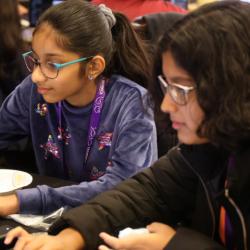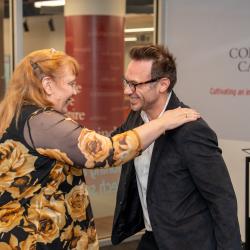Mapping the Twitterverse
COLLEGE PARK, Md. – A University of Maryland computer scientist is part of a major study that offers a topographical “map” of Twitter users, visually identifying six distinct structures in the social networking system’s online discussions of a wide range of topics.
Ben Shneiderman, a professor of computer science with an appointment in the university’s Institute for Advanced Computer Studies (UMIACS), co-authored the comprehensive study released Feb. 20 by the Pew Research Internet Project in conjunction with the Social Media Research Foundation.
Shneiderman says the study — which provides an analysis of tens of thousands of Twitter conversations over the past four years and can be downloaded here — is the first of its kind.
“There are already a number of academic papers that analyze the volume of tweets over time related to specific topics, and other research that gives good insight into sentiment analysis—the underlying message—of those tweets,” he says. “What we’ve done doing is to provide a visual map of the Twitterverse that will ultimately help others to better interpret the trends, topics and implications of these new communication technologies.”
The Pew Research study was conducted by Shneiderman; Lee Raine, director of the Pew Research Internet Project; Marc Smith, director of the Social Media Research Foundation; and Itai Himelboim, a telecommunications researcher from the University of Georgia.
The research group identified six patterns, each showing identifiable contours, based on the topic being discussed, the information and influencers driving the conversation, and the social network structures of the participants.
“It gave us a way to take the digital equivalent of aerial photos of crowds while simultaneously listening to their conversations,” says Raine.
The six networks identified by the researchers are:
• “Polarized crowds” that often form around political topics, with users heavily engaging with others in their own group by sharing links, images and other information readily, while communicating very little with people who have opposing viewpoints.
• “Tight crowds” that share information related to popular topics that they are passionate about, including professional conferences and hobby groups.
• “Brand clusters” that form around products and celebrities. The researchers found that Twitter discussions of well-known products and services—or popular celebrities—frequently bring together people with no other connection to one another.
• “Community clusters” that develop around global news, with popular topics spawning multiple smaller groups, each with its own audience, influencers and sources of information.
• “Broadcast network” structures that are created when people re-tweet breaking news and commentary. The Pew Research study found that people in this network re-tweet posts from prominent news and media organizations, while interacting very little with others re-tweeting the same news.
• “Support network” conversations that revolve around a singular source, such as customer complaints about a major business.
The researchers relied heavily on open-source software called NodeXL to interpret the data. Marc Smith led the initial development of this innovative software, but Shneiderman and his graduate students—many of them in the university’s Human-Computer Interaction Lab—have contributed strongly to the analytical tool’s use over the past six years.
NodeXL allows researchers to examine the interplay of tweets, retweets and the social networks of Twitter users—the people they follow and who follows them. It can also be used to study Facebook, Flickr, email, scientific citations and other network structures.
“This new field is emerging right before our eyes,” Shneiderman says. “It could eventually have a large impact on our understanding of everything from health to community safety, from business innovation to citizen science, and from civic engagement to sustainable energy programs.”
Contact: Tom Ventsias 301-405-5933







